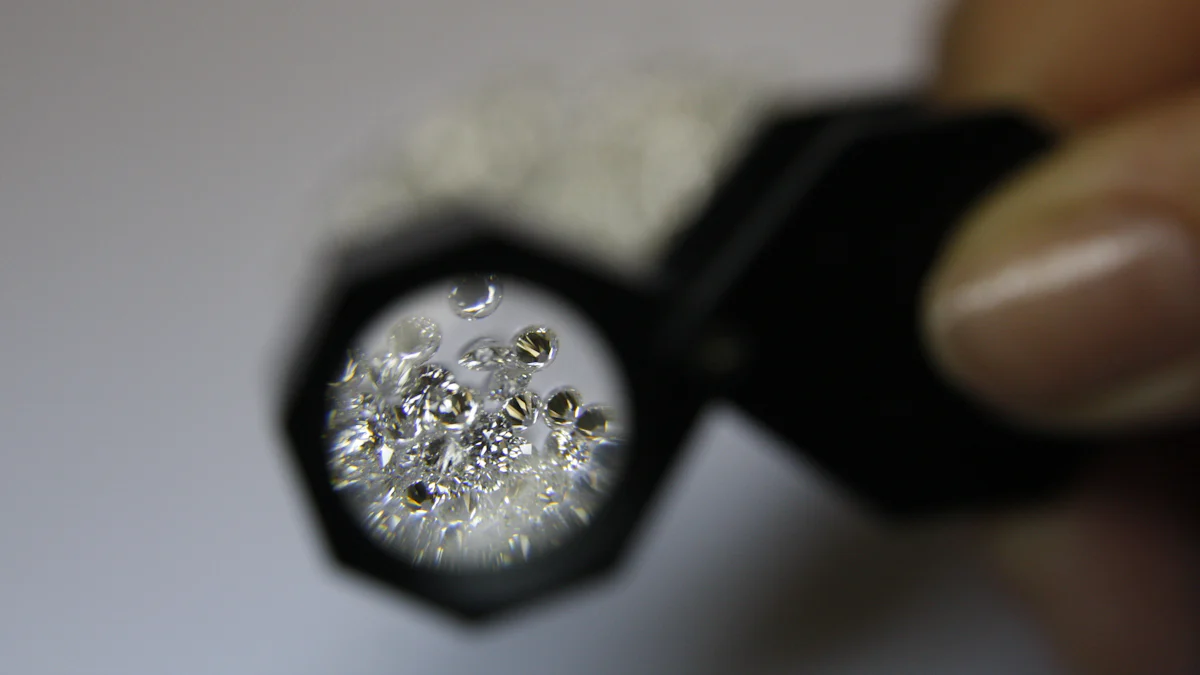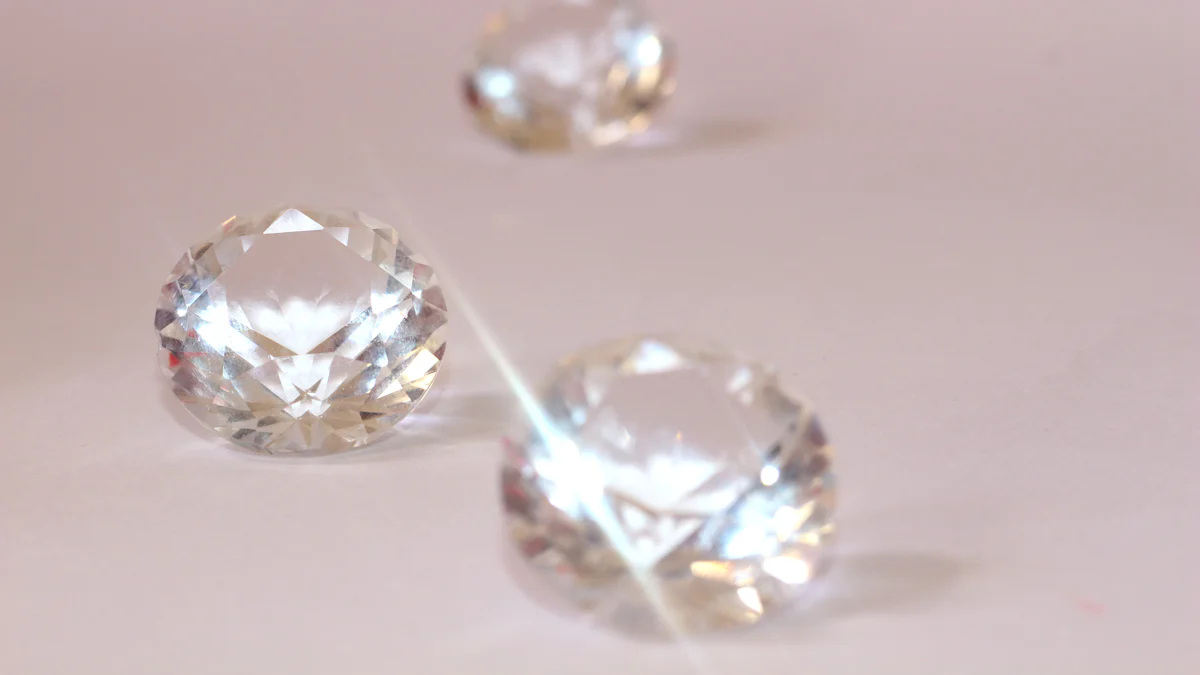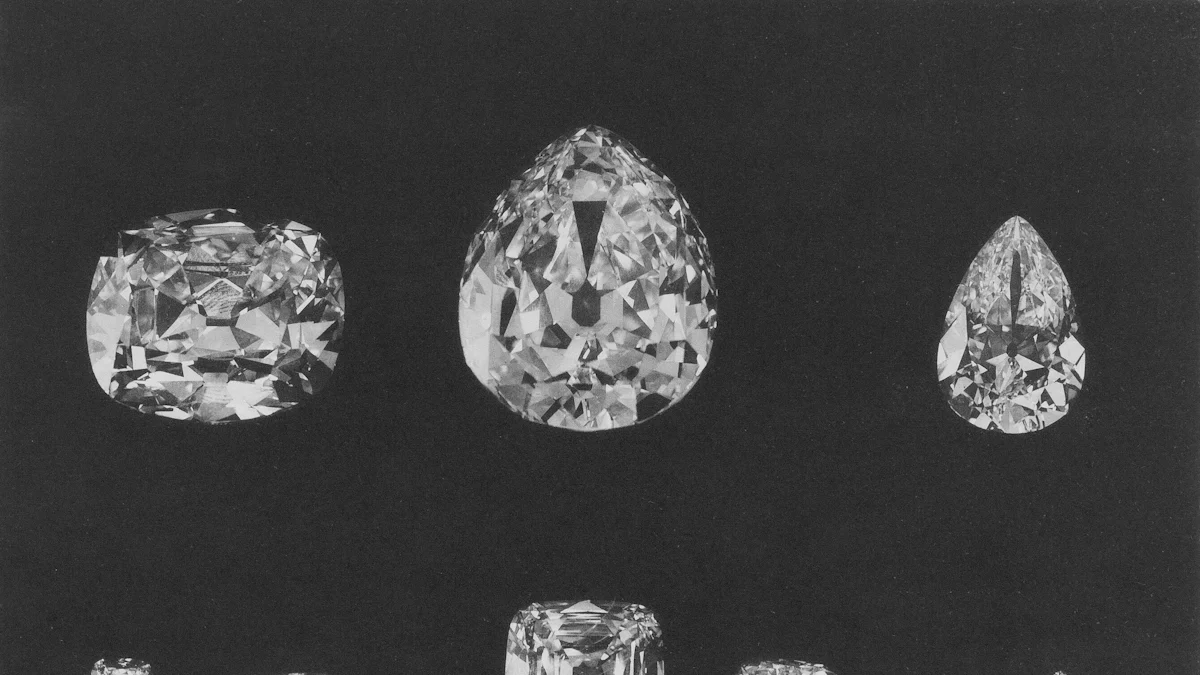What are the top diamond clarity grades in 2025?

When you're shopping for diamonds, clarity plays a huge role in determining their beauty and value. The top diamond clarity grades in 2025—FL (Flawless), IF (Internally Flawless), VVS1, and VVS2—are all about perfection. These grades highlight diamonds with little to no visible inclusions, making them sparkle brilliantly. For instance, flawless diamonds, which are incredibly rare, have seen a rise in demand, with prices increasing from $12,087 to $12,351 in early 2025. This trend reflects a growing appreciation for premium-quality stones. Whether you're drawn to the timeless appeal of an Emerald cut or the unique charm of an Oval shape, clarity-focused diamonds remain a top choice for buyers like you.
What is Diamond Clarity?

Definition of Diamond Clarity
When you hear the term "diamond clarity," it refers to how free a diamond is from imperfections. According to the Gemological Institute of America (GIA), clarity measures the absence of inclusions and blemishes. Inclusions are internal flaws, while blemishes are surface imperfections. These tiny details might seem insignificant, but they play a huge role in determining the quality of a diamond. A diamond with fewer imperfections sparkles more brilliantly and holds greater value. So, when you're shopping for diamonds, understanding clarity helps you make smarter choices.
How Clarity is Evaluated
Evaluating clarity is a detailed process. Gemologists use specific tools and methods to assess a diamond's clarity grade. They examine the diamond under 10x magnification to spot inclusions and blemishes. Proper lighting and a neutral background make it easier to see these imperfections. Experts then map out the size, number, position, color, and nature of the flaws. For example, inclusions near the center of the diamond are more noticeable and can lower its clarity grade. To ensure accuracy, multiple experts often review the diamond before assigning a final grade. This process is part of what makes diamond grading so reliable.
Some common factors that affect clarity include:
- Size: Larger inclusions are more visible and impactful.
- Number: More inclusions mean a lower clarity grade.
- Position: Flaws near the center are more obvious than those on the edges.
- Nature: Internal flaws like feathers or clouds can affect durability and brilliance.
- Relief: The contrast between the diamond and its inclusions determines how visible they are.
Why Clarity is Important in Diamonds
Clarity is one of the most critical factors in diamond certification. It directly impacts the diamond's beauty and value. Higher clarity diamonds are rarer, which makes them more desirable and expensive. They also have fewer visible imperfections, giving them a cleaner, more appealing look. For instance, inclusions like clouds can dull a diamond's brilliance, while feathers might affect its durability. When you choose a diamond with a high clarity grade, you're investing in a stone that looks stunning and holds its value over time.
If you're wondering whether clarity should be your top priority, think about how much it affects the diamond's appearance. A higher clarity grade ensures fewer distractions, letting the diamond's natural sparkle shine through.
Top Diamond Clarity Grades in 2025

FL (Flawless)
Features of Flawless Diamonds
Flawless diamonds are the pinnacle of perfection. To earn this top diamond clarity grade, a diamond must pass a rigorous examination by gemologists. Here’s what makes them stand out:
- No internal inclusions or external blemishes are visible under 10x magnification.
- They sit at the very top of the GIA’s Clarity Grading Scale.
- Less than 1% of diamonds achieve this grade after cutting and polishing.
These diamonds are incredibly rare and represent the highest level of brilliance and purity. If you’re looking for a diamond that’s truly one-of-a-kind, flawless diamonds are unmatched.
Why FL is the Top Diamond Clarity Grade
Flawless diamonds are not just rare—they’re extremely rare. In fact, they make up less than half a percent of all diamonds on the market. This rarity drives their value, with prices often 25-35% higher than internally flawless diamonds. For example, in 2025, a 1.06-carat flawless diamond costs $14,160, compared to $9,430 for a similar internally flawless diamond. Their unmatched purity and brilliance make them the ultimate choice for collectors and connoisseurs.
IF (Internally Flawless)
Features of Internally Flawless Diamonds
Internally flawless diamonds are another exceptional clarity grade. They have no internal inclusions visible under 10x magnification, though they may have minor surface blemishes. Like flawless diamonds, they appear pristine to the naked eye and offer incredible brilliance. These diamonds are rare, representing less than 1% of all diamonds, making them a highly desirable option for buyers seeking near-perfection.
How IF Differs from FL
While both grades are near-perfect, the key difference lies in surface blemishes. Flawless diamonds are completely free of both internal and external imperfections, while internally flawless diamonds may have slight surface marks. Despite this, both grades deliver stunning brilliance and are indistinguishable to the naked eye. However, flawless diamonds command a higher price due to their extreme rarity.
VVS1 (Very Very Slightly Included 1)
Features of VVS1 Diamonds
VVS1 diamonds are known for their extraordinary clarity. Their inclusions are so tiny that even experts struggle to spot them under magnification. Here’s why they’re so highly regarded:
- They’re rare and near-pristine, symbolizing quality and beauty.
- Their exceptional clarity enhances brilliance and allure.
- A VVS1 diamond with a high color grade and exquisite cut is considered collector-worthy.
If you want a diamond that balances rarity and value, VVS1 diamonds are an excellent choice.
Why VVS1 is a Popular Choice
VVS1 diamonds offer a perfect blend of beauty and investment potential. They maintain their value over time, especially when paired with superior cut and color grades. Their rarity and brilliance make them a favorite among buyers who want a diamond that stands out without reaching the price of flawless or internally flawless diamonds. For many, VVS1 represents the sweet spot of quality and affordability.
VVS2 (Very Very Slightly Included 2)
Features of VVS2 Diamonds
VVS2 diamonds are a fantastic choice if you’re looking for exceptional clarity without the premium price tag of flawless or internally flawless stones. These diamonds have tiny inclusions that are almost impossible to see, even under 10x magnification. You’d need a trained gemologist and specialized tools to spot them. To the naked eye, they look just as clean and brilliant as higher clarity grades.
Here’s what makes VVS2 diamonds stand out:
- Their inclusions are minimal and located in less noticeable areas.
- They offer incredible brilliance and sparkle, making them visually stunning.
- They’re more affordable than VVS1 diamonds, giving you great value for your money.
If you’re shopping for a diamond that balances beauty and budget, VVS2 is a top diamond clarity option. It’s perfect for engagement rings or other jewelry where brilliance matters most.
Comparing VVS2 to VVS1
You might wonder how VVS2 differs from VVS1. The main difference lies in the size and position of inclusions. VVS2 diamonds have slightly larger or more centrally located inclusions compared to VVS1. However, these inclusions are still so tiny that they don’t affect the diamond’s overall appearance or sparkle.
From a value perspective, VVS2 diamonds are often more budget-friendly than VVS1. If you’re looking for a diamond that looks flawless to the naked eye but costs less, VVS2 is an excellent choice. Both grades deliver exceptional quality, but VVS2 gives you a bit more flexibility when it comes to price.
Tip: When choosing between VVS1 and VVS2, consider the diamond’s size and setting. Smaller diamonds or intricate settings can hide inclusions, making VVS2 an even smarter choice.
How Clarity Grades Impact Diamond Value
The Relationship Between Clarity and Price
Clarity plays a huge role in determining a diamond's price. Higher clarity grades mean fewer inclusions, making the diamond rarer and more valuable. For example, a diamond with SI2 clarity might sell for $6,500, while a similar one with VVS1 clarity could cost $13,500. That’s a 100% price jump for just a five-grade difference! If you compare this to internally flawless diamonds, the price gap becomes even more dramatic.
Diamonds with fewer imperfections also look more appealing. Their brilliance and sparkle are unmatched, which is why they command premium prices. The rarity of high-clarity diamonds, combined with their visual perfection, makes them a top choice for collectors and anyone looking for a long-term investment.
Clarity vs. Other Diamond Characteristics (Cut, Color, Carat)
Clarity isn’t the only factor to consider when choosing a diamond. Other characteristics like cut, color, and carat size also play a big role. A well-cut diamond can enhance its clarity by making inclusions less noticeable. On the other hand, a poorly cut diamond might highlight imperfections, even if it has a high clarity grade.
Color and clarity often go hand in hand. A diamond with slightly lower clarity but excellent color can still look stunning. However, as carat size increases, inclusions become more visible. Larger diamonds need higher clarity grades to maintain their beauty. Balancing these factors is key to finding the perfect diamond for your needs.
When to Prioritize Clarity in Your Purchase
You should prioritize clarity when it significantly impacts the diamond’s appearance. This is especially true for larger diamonds or certain shapes like emerald cuts, where inclusions are easier to spot. If you’re working with a smaller budget, you might focus on other factors like cut or color instead.
Your personal preferences also matter. If you value a flawless look, investing in a higher clarity grade makes sense. But if you’re more flexible, you can save money by choosing a diamond with slightly lower clarity that still looks beautiful to the naked eye. Ultimately, clarity is just one piece of the puzzle in finding the perfect diamond.
Tips for Choosing the Right Clarity Grade
Consider Your Budget
Your budget plays a big role in deciding which diamond clarity grade works best for you. Higher clarity diamonds, like flawless or internally flawless, are rare and come with a premium price tag. If you’re working with a tighter budget, you can still find beautiful diamonds by focusing on eye-clean options. These diamonds have no visible inclusions to the naked eye, even if their clarity grade is slightly lower. For example, a VVS2 or VS1 diamond might look just as stunning as a flawless one but cost significantly less.
To maximize value, think about how clarity fits into your overall priorities. If you’re more focused on size or cut, you can save money by choosing a diamond with a lower clarity grade that still looks brilliant. Remember, the goal is to find a balance that works for your wallet and your preferences.
Think About Diamond Size and Setting
The size and setting of your diamond can make clarity more or less important. Larger diamonds have bigger facets, which means inclusions are easier to spot. If you’re choosing a diamond over 1 carat, you might want to prioritize a higher clarity grade to avoid visible flaws.
The setting also matters. In engagement rings or other jewelry where the diamond is closely viewed, clarity becomes more crucial. Certain settings, like solitaires, showcase the diamond prominently, making inclusions more noticeable. On the other hand, intricate settings or halo designs can hide minor imperfections.
Here are a few things to keep in mind:
- Larger inclusions have a bigger impact on appearance.
- Inclusions near the center of the diamond are more visible.
- Settings with prongs or side stones can help mask small flaws.
By considering size and setting, you can choose a clarity grade that enhances the diamond’s overall beauty.
Balance Clarity with Other Factors
Clarity is important, but it’s just one piece of the puzzle. You also need to think about how it interacts with other diamond characteristics like cut, color, and carat. A well-cut diamond can make inclusions less noticeable by reflecting light more effectively. Similarly, a diamond with excellent color might outshine one with higher clarity but poor color.
Larger diamonds often require higher clarity grades to maintain their visual appeal. However, if you’re choosing a smaller diamond, you might prioritize cut or color instead. Balancing these factors ensures you get a diamond that looks stunning without overspending.
Ultimately, clarity should align with your personal preferences and the diamond’s intended use. Whether you’re buying for an engagement ring or as an investment, understanding how clarity fits into the bigger picture will help you make a confident choice.
The top diamond clarity grades in 2025—FL, IF, VVS1, and VVS2—offer unmatched brilliance and quality. Each grade has its strengths, so your choice depends on your budget and what matters most to you. Want a flawless look? Go for FL or IF. Prefer value? VVS1 or VVS2 might be perfect.
To balance clarity with other factors:
- Choose a well-cut diamond to hide inclusions and boost sparkle.
- Consider better color or larger carat if clarity isn’t your top priority.
- A slightly lower clarity grade can still look stunning when paired with the right cut.
Your ideal diamond is all about finding the right mix!
FAQ
What does "eye-clean" mean in diamond clarity?
An "eye-clean" diamond has no visible inclusions when viewed with the naked eye. These diamonds may have minor flaws under magnification, but they appear flawless to you. Eye-clean diamonds are a great choice if you want beauty without paying for higher clarity grades.
Should I always choose the highest clarity grade?
Not necessarily! Higher clarity grades like FL or IF are stunning but come with a premium price. If you’re on a budget, VVS1 or VVS2 diamonds can look just as brilliant to the naked eye. Focus on what fits your needs and wallet.
Does diamond shape affect clarity visibility?
Yes, it does. Shapes like emerald or asscher cuts have larger, open facets that make inclusions more noticeable. Round or brilliant cuts hide flaws better. If clarity is a concern, choose a shape that minimizes the visibility of inclusions.
Can inclusions affect a diamond’s durability?
Some inclusions, like feathers or cracks, can weaken a diamond’s structure. While most inclusions are harmless, you should avoid diamonds with flaws near the edges. These could chip over time. Always ask your jeweler about durability before buying.
How do I balance clarity with other diamond factors?
Start by deciding what matters most to you—size, sparkle, or color. If clarity isn’t your top priority, choose a slightly lower grade like VS1 or VS2. Pair it with an excellent cut to maximize brilliance. This approach gives you the best value.
Tip: Always view the diamond in person or request high-quality images to ensure it meets your expectations.
See Also
A Comprehensive Guide To Engagement Ring Diamond Cuts
Best Lab-Grown Diamond Tennis Bracelets To Buy In 2024
Key Characteristics Of A Perfect Diamond Ring

